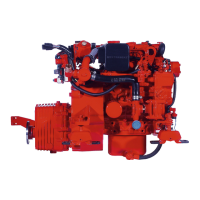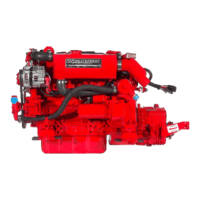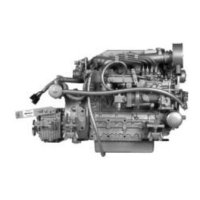TESTING
FOR
OVERHAUL
HOW
TO
JUDGE
ENGINE
OVERHAUL
PERIOD
Cause
of
Low
Compression
Generally, the time at which
an
engine should be overhauled
is determined by various conditions such as lowered engine
power output, decreased compression pressure, and increased
fuel and oil consumption. The lowered engine power output,
in
the case
of
diesel engines, is not necessarily due to trouble
with the engine itself, but is sometimes caused by injector
nozzle wear or injection pump wear.
It is most reasonable to
judge by a decrease
in
compression pressure. The decrease in
compression pressure is caused by many factors.
It is, there-
fore, necessary to determine a cause or causes on the basis
of
data
of
periodic inspection and maintenance. Oil analysis on
a seasonal basis is a good means
of
monitoring engine inter-
nal wear. When caused by worn cylinders or piston rings, the
following symptoms will occur:
Low engine power output
Increased fuel consumption
Increased oil consumption
Hard engine starting
Noisy engine operation
These symptoms often appear together. Increased fuel con-
sumption and hard engine starting can result also from exces-
sive fuel injection, improper injection timing, and wear
of
plugs and nozzles. They are caused also by defective electri-
cal devices such as the battery, alternator, starter and glow
plugs. Therefore
it
is desirable to judge the optimum engine
overhaul time by the lowered compression pressure caused
by worn cylinders and pistons plus increased oil consump-
tion.
In
diesel engines, satisfactory combustion is obtained
only under sufficient compression pressure. If an engine
lacks compression pressure, incomplete combustion
of
fuel
will take place even
if
other parts
of
the engine are operating
properly.
To
judge the period
of
engine overhaul,
it
is impor-
tant to measure the engine compression pressure regularly. At
the same time, the engine speed at which measurement
of
compression pressure is made should be checked because the
compression pressure varies with engine rpm.
The engine rpm can be measured at the front end
of
the
crankshaft.
Measuring
Compression
Pressure
To
check the compression pressure, follow this procedure:
1.
Warm the engine.
2.
Remove all the fuel injectors or all the glow plugs from
the cylinder block.
3. Disconnect the fuel solenoid from the throttle arm (gen-
erator models only).
4. Place the stop lever
in
the OFF position (propulsion mod-
els only).
5. Install a pressure gauge adapter
in
the first injector hole
or glow plug hole to be tested.
6. Connect the pressure gauge to the adapter.
7. Crank the engine with the starter motor until the pressure
reaches a maximum value. Read the engine rpm and the
pressure gauge when the starter rotation has become
sta-
ble.
8. Repeat the above procedure for each cylinder.
9. If the compression differs
by
more than 42.7 psi (3.0
kglcm2)
at 200 rpm, then determine the cause
of
the low
pressure, and repair as necessary.
NOTE:
Do
not guess the conditions
of
other cylinders from a
result
of
testing one cylinder.
Be
sure to measure the com-
pression pressure for each cylinder. Look for cylinders with
dramatically (at least 20%) lower compression than the aver-
age
of
the other cylinders.
If
the weak cylinder is flanked by
healthy cylinders, the problem is either valve-
or
head-gasket
related.
Very
low compression in an adjacent cylinder points
to gasket failure. Abnormally high readings on all cylinders
indicate heavy carbon accumulations, a condition that might
be
accompanied
by
high pressures and noise.
NOTE:
In case
of
severe vibrations and detonation noise,
have the injectors overhauled by an authorized fuel injection
service center. Poor fuel quality, contaminates, and loss
of
positive fuel pressure to the injection
pump
will result in
injector faults.
OVERHAUL
CONDITIONS
Compression pressure tends
to
increase a little in a new
engine until piston rings and valve seats have been broken in.
Thereafter,
it
decreases gradually with the progress
of
wear
of
these parts.
When decrease
of
compression pressure reaches the repair
value, the engine must be overhauled.
The engine requires overhaul when oil consumption is high,
blowby evident, and
compr~ssion
valves at minimum
or
below. Engine compression should be
32
kglcm2
(at 280
rpm). See SERVICE STANDARDS chart.
NOTE:
The SERVICE STANDARDS chart gives the values for
repair
or
replacement
of
the engine components. Refer to
these values
and
measurements during engine overhaul.
Disassembly
1. Before disassembly and cleaning, carefully check for
defects which cannot be found after disassembly and
cleaning.
2. Drain water, fuel and oil before disassembly.
3. Clean
or
wash the engine exterior.
4. Do not remove
or
disassemble the parts that require no
disassembly.
Engines & Generators
6

